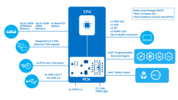Intel HD Graphics P630 vs Intel UHD Graphics (Elkhart Lake 32 EU)
Intel HD Graphics P630
► remove from comparison
Die Intel HD Graphics P630 (GT2) ist eine integrierte Workstation-Grafikeinheit, die in verschiedenen Desktop- und Notebook-Prozessoren der 2017 vorgestellten Kaby-Lake-Generation zu finden ist (Xeon E3-1200 v6 und e3-1500M v6 Serien). Sie ist identisch mit der Intel HD Graphics 630, jedoch sind die Treiber für professionelle Software optimiert. Daher unterscheidet sie sich auch nicht von der Intel HD Graphics P530 und erreicht laut Intel auch die selbe Leistung im SPEC Viewperf12 (1.94x der alten Intel HD Graphics P4000). Die Grafikkarte ist derzeit für 15 CAD- und Workstation-Anwendungen zertifiziert.
Features
Neu bei der Kaby-Lake Generation ist die verbesserte Videoengine, welche nun auch H.265/HEVC im Main10-profil mit 10 Bit Farbtiefe sowie Googles VP9-Codec in Hardware dekodieren kann. Die Chips mit HD Graphics 530 sollten auch bereits HDCP 2.2 unterstützen und somit z.B. Netflix-Videos unter Windows 10 in 4K ausgeben können (im Gegensatz zu den ersten Kaby-Lake Dual-Core Chips mit Intel HD Graphics 620).
Leistungsaufnahme
Die HD Graphics P630 ist in Desktop- und Notebook-Prozessoren verschiedener TDP-Klassen zu finden. Die Quad-Core CPUs sind jedoch meistens in größeren und schwereren Notebooks verbaut. Der verbesserte 14nm+ Prozess verspricht jedoch eine etwas geringere Leistungsaufnahme im Vergleich zur Intel HD Graphics P530.
Quelle: http://www.intel.com/content/dam/www/public/us/en/documents/guides/hd-graphics-performance-guide.pdf
Intel UHD Graphics (Elkhart Lake 32 EU)
► remove from comparison
Die Intel UHD Graphics 32 EUs (Elkhart Lake, Gen. 11) ist eine Prozessorgrafikkarte, die im Januar 2021 vorgestellt wurde. Sie wird in den High-End-Modellen der Elkhart Lake Prozessoren genutzt (z.B. Pentium J6426) und bietet alle 32 EUs (Executing Units - Shader Cluster). Weiterhin hat die iGPU keinen eigenen dedizierten Grafikspeicher. Die Taktung ist abhängig vom CPU-Modell und variiert von 400 - 850 MHz (minimaler Basis bis maximaler Boost-Takt).
| Intel HD Graphics P630 | Intel UHD Graphics (Elkhart Lake 32 EU) | ||||||||||||||||||||||||||||||||||||||||||||||||||||||||||||||||||||||
| Gen. 11 Serie |
|
| |||||||||||||||||||||||||||||||||||||||||||||||||||||||||||||||||||||
| Codename | Kaby-Lake-H-GT2 | Gen. 11 | |||||||||||||||||||||||||||||||||||||||||||||||||||||||||||||||||||||
| Architektur | Gen. 9.5 Kaby Lake | ||||||||||||||||||||||||||||||||||||||||||||||||||||||||||||||||||||||
| Pipelines | 24 - unified | 32 - unified | |||||||||||||||||||||||||||||||||||||||||||||||||||||||||||||||||||||
| Speicherbandbreite | 64/128 Bit | ||||||||||||||||||||||||||||||||||||||||||||||||||||||||||||||||||||||
| Shared Memory | ja | ja | |||||||||||||||||||||||||||||||||||||||||||||||||||||||||||||||||||||
| API | DirectX 12_1, OpenGL 4.4 | DirectX 12_1, OpenGL 4.5, OpenCL 1.2 | |||||||||||||||||||||||||||||||||||||||||||||||||||||||||||||||||||||
| Herstellungsprozess | 14 nm | 10 nm | |||||||||||||||||||||||||||||||||||||||||||||||||||||||||||||||||||||
| Features | QuickSync | QuickSync | |||||||||||||||||||||||||||||||||||||||||||||||||||||||||||||||||||||
| Erscheinungsdatum | 05.08.2015 | 11.01.2021 | |||||||||||||||||||||||||||||||||||||||||||||||||||||||||||||||||||||
| Kerntakt | 400 - 850 (Boost) MHz | ||||||||||||||||||||||||||||||||||||||||||||||||||||||||||||||||||||||
| Stromverbrauch | 4.8 - 10 Watt | ||||||||||||||||||||||||||||||||||||||||||||||||||||||||||||||||||||||
| Displays | 3 Displays (max.) | ||||||||||||||||||||||||||||||||||||||||||||||||||||||||||||||||||||||
| Predecessor | UHD Graphics 600 |
| |||||||||||||||||
Benchmarks
Average Benchmarks Intel HD Graphics P630 → 0% n=0
* Smaller numbers mean a higher performance
1 This benchmark is not used for the average calculation
Eine Liste mit weiteren Spielen und allen Grafikkarten finden Sie auf unserer Seite: Welches Spiel ist mit welcher Grafikkarte spielbar?











